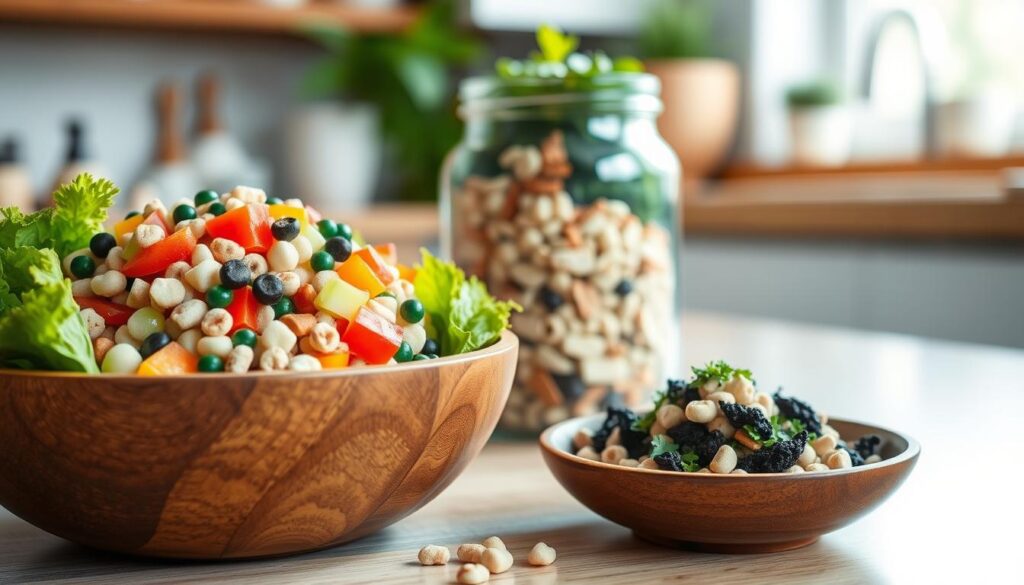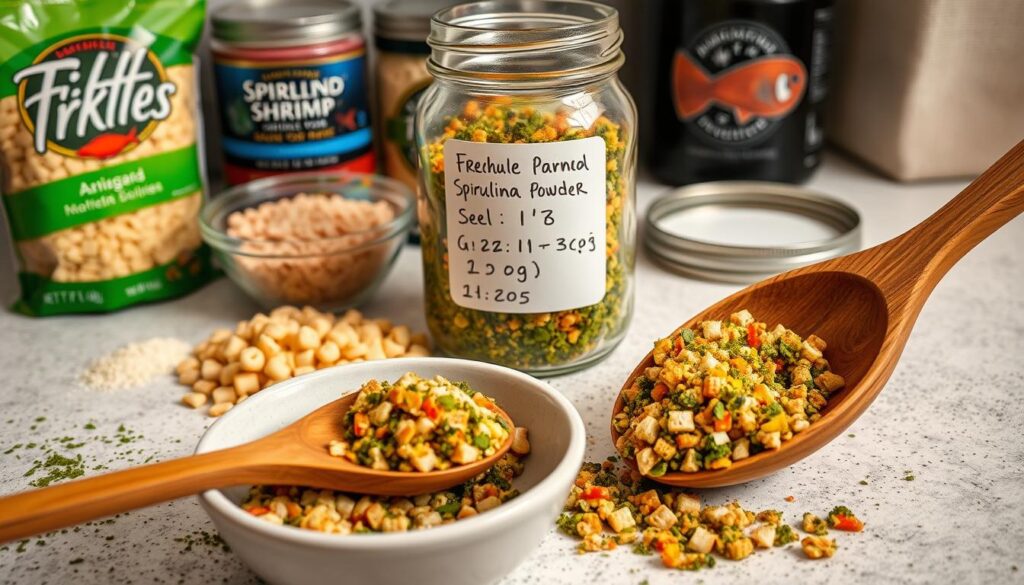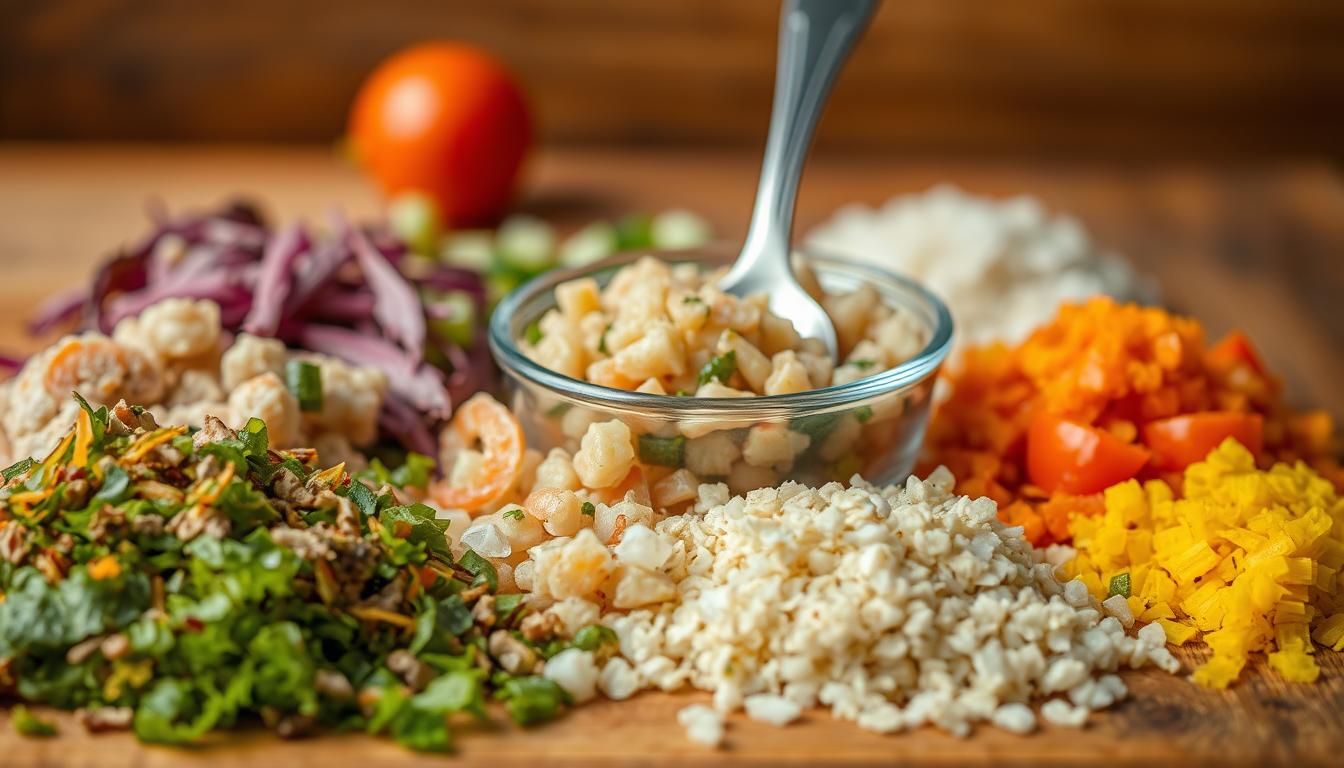Table of Contents
I remember the first time I made homemade fish food for my pet fish. It was fun and rewarding. My fish loved it. Making your own fish food at home has many benefits, like controlling what goes into it.
It’s a great way to ensure your pets get the best nutrition. You can pick the ingredients and quality. This is important for fish with special dietary needs. Making your own fish food can be a fun and rewarding experience.
Using a fish food recipe can help you give your pets a healthy diet. With the right ingredients and creativity, you can make tasty and nutritious food. Making your own fish food saves money and lets you control the quality.
Introduction to Homemade Fish Food
In this article, we’ll explore homemade fish food and share easy recipes your pets will love. We’ll talk about the benefits, like saving money and controlling what goes into the food. We’ll also cover the essential ingredients and tools you need to start making homemade fish food.
Key Takeaways
- Making your own fish food at home can be a fun and rewarding experience
- Using a fish food recipe can help you control the ingredients and quality of the food
- Homemade fish food can provide a healthy and balanced diet for your pets
- Making your own fish food at home can save you money
- With the right ingredients and tools, you can create delicious and nutritious homemade fish food
- Homemade fish food can be customized to meet the specific dietary needs of your pets
Why Make Your Own Fish Food at Home
Making your own fish food at home is a great way to feed your pets well. You can avoid bad ingredients in commercial food. This saves money and lets you choose what goes into your fish’s food.
One big plus is saving money. Fish food can cost a lot, but homemade is cheaper. You can also pick ingredients that fit your fish’s needs, making their food healthier.
- Control over ingredients and quality
- Cost savings compared to commercial fish food
- Customization to meet the specific needs of your fish
- Healthy and balanced diet for your pets
By making your own fish food, you give your pets the nutrients they need. With a bit of effort, you can make a tasty, healthy food for them.
Essential Ingredients for Fish Food Recipe Success
To make the best fish food, you need a mix of key ingredients. These give your fish a balanced and healthy diet. Start with protein sources like fish meal, shrimp meal, and squid meal. Add vegetables like spirulina, kale, and spinach for extra vitamins and minerals.
You also need fat and carbohydrates. Use fish oil or flaxseed oil for fat, and whole wheat flour or oats for carbs. These help make a complete and nutritious diet for your fish. Choose ingredients that fit your fish’s specific needs.
Some important ingredients for your fish food are:
- Protein sources: fish meal, shrimp meal, squid meal
- Vegetable sources: spirulina, kale, spinach
- Fat sources: fish oil, flaxseed oil
- Carbohydrate sources: whole wheat flour, oats
With these ingredients, you can make a diet that’s right for your fish. Always pick high-quality ingredients. And use a recipe made for your fish type. With the right mix and a bit of practice, you can make a tasty and healthy fish food that your fish will enjoy.
Basic Tools and Equipment Needed
To start making your own fish food, you’ll need some basic tools. The right tools make the process easier and more efficient. This way, you can create a simple fish food recipe that your pets will enjoy.
Some essential items include a food processor or blender, a mixing bowl, and a measuring cup. These tools help you prepare and mix the ingredients for your fish food recipe.
Kitchen Tools Required
You may also need some kitchen tools like a spoon, spatula, and cutting board. These tools are useful when preparing and handling the ingredients for your fish food recipe.
Storage Containers and Supplies
After preparing your fish food, you’ll need to store it in airtight containers. Use glass jars or plastic bags to keep your homemade fish food fresh. This helps maintain the quality and freshness of your simple fish food recipe.
The Perfect Fish Food Recipe for Beginners
Making your own fish food recipe can seem hard at first, but it’s easy. You just need a few basic ingredients to make a healthy diet for your fish. A good homemade fish food recipe has protein, veggies, and fats.
Here are some key ingredients for your fish food recipe:
- Protein sources: fish meal, shrimp meal, or spirulina
- Vegetable sources: peas, carrots, or spinach
- Fat sources: fish oil or flaxseed oil
Start with a simple homemade fish food recipe that mixes these ingredients. Always check what your fish needs before changing their diet.

By using a simple fish food recipe and fresh ingredients, you can feed your fish well. With practice, you’ll get good at making homemade fish food and care for your fish better.
Advanced Homemade Fish Food Variations
Exploring homemade fish food has shown me how easy it is to keep my fish healthy. A good recipe can really help them grow. I’ve learned to make different recipes to meet their needs.
Making my own fish food lets me choose what they eat. I can add protein-rich foods like shrimp or fish meal. This way, I ensure they get the nutrients they need.
Some advanced recipe options include:
- Protein-rich recipes featuring ingredients like shrimp or fish meal
- Vegetarian fish food alternatives using spirulina or pea protein
- Species-specific recipes tailored to the unique needs of different fish species
Trying out these recipes has been rewarding. I can now offer my fish a variety of healthy meals. Whether it’s a protein-rich dish or a veggie option, I can tailor their diet. This way, I make sure they enjoy their food and stay healthy.
| Recipe Type | Ingredients | Nutritional Benefits |
|---|---|---|
| Protein-Rich | Shrimp, fish meal, peas | High protein content, supports growth and development |
| Vegetarian | Spirulina, pea protein, spinach | Rich in vitamins and minerals, supports immune function |
| Species-Specific | Varying ingredients depending on species | Meets unique nutritional needs of different fish species |
Storage and Preservation Tips
After making your own fish food, it’s key to store it right. This keeps it fresh and full of nutrients. Use airtight containers to keep the best fish food recipe fresh longer. These containers block moisture and contaminants.
To keep your homemade fish food fresh, store it in the fridge or freezer. This slows down spoilage and keeps nutrients in the best fish food recipe. Vacuum sealing containers also helps prevent spoilage.
Here are some tips for storing and preserving your fish food:
- Store the fish food in a cool, dry place
- Keep the containers away from direct sunlight
- Use airtight containers to prevent moisture and contaminants
- Label the containers with the date and contents
By following these tips, you can keep your homemade fish food fresh and nutritious. Always check the food for spoilage before feeding it. Discard any expired or contaminated food to keep your fish healthy.
Common Mistakes to Avoid When Making Fish Food
Making your own fish food can be simple, but it’s crucial to avoid common mistakes. These mistakes can harm your fish’s health and nutrition. By paying attention to detail, you can make a delicious and nutritious fish food recipe.
Common errors include:
- Choosing the wrong ingredients can lower the food’s nutritional value.
- Not preparing the food correctly can lead to spoilage or contamination.
- Incorrect storage can make the food stale or rancid.
Knowing these mistakes helps you avoid them. Always use fresh ingredients and follow food safety guidelines. This ensures your fish stay healthy and happy.
Feeding Schedule and Portion Control
Now that you’ve made your own fish food recipe, it’s key to feed your fish the right amount. A good feeding schedule keeps your fish healthy and happy. With homemade fish food, it’s easy to overfeed, which can harm your fish and the water quality.
To figure out how much to feed, think about your fish’s size, species, and how active they are. Feed them 2-3 times a day, just enough for them to eat in a few minutes. Also, mix up the foods you give them to make sure they get a balanced diet.

Feeding Guidelines
- Feed your fish in the morning and evening, when they are most active
- Offer a variety of foods, including vegetables and protein sources
- Monitor your fish’s appetite and adjust the amount of food as needed
By following these tips and using your homemade fish food recipe, you can keep your fish healthy and happy. Always put your fish’s nutritional needs first and adjust their feeding schedule as needed for the best care.
Conclusion: Making the Switch to Homemade Fish Food
Making your own fish food at home is rewarding and educational. By using the recipes and tips from this guide, you can give your fish a diet that’s just right for them. You get to choose what goes into their food, ensuring they eat the best.
When you start making your own fish food, do your homework. Talk to other fish keepers and always think about what’s best for your fish. Soon, you’ll be making tasty meals for your fish that they’ll love.
So, why wait? Begin making your own fish food today. See how it improves your fish’s health and energy. Bon appétit, fishy friends!

